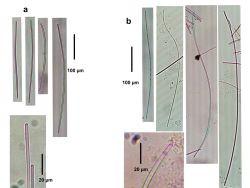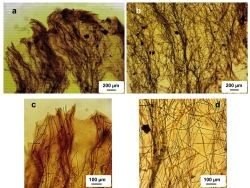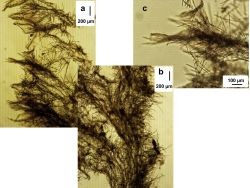orange
bushy
lobate
tube
soft
Bahamas
Auletta sp.-"orange bush-lobe-tube"
Description: Groups of basally fused lobes or tubes arising from a narrow or wide base, with membranous oscules on the tops. Surface with low-lying, parallel lamellae, made up of a membranous pinacoderm stretching over skeletal ridges, which become more pronounced when the sponge is taken out of the water and the pinacoderm collapses. One specimen was made up of a cluster of basally fused thin tubes with an almost even surface (although the ridges could still be discerned). Size up to 5-10 cm wide and tall. Color bright orange. Consistency softly compressible, somewhat difficult to tear. Ectosome organic, supported by the ends of ascending spicule tracts and brushes. Skeleton made of ascending, dividing and diverging but also anastomosing plumose spicule tracts, from 2-3 to up to about 5-8 spicule thick, surrounded by spongin, with spicules echinating perpendicular or diagonally upwards. Spicules in two types: (a) Thin, slightly curved styles with rather blunt tips, 200-380 µm long by 3.7-8 µm wide; (b) curved to sinuous strongyles, thin and slender, usually longer than the styles, 350-710 µm long by 2.5-4.5 µm wide.
Notes: This species has been seen in deep reef open sites in the Bahamas. We had initially erroneously identified our material as possibly Acanthella mastophora (Schmidt, 1870), but then later realized it differs in the texture (parchment-like membrane) and spiculation (sinuous anisoxeas instead of strongyles). Most specimens can fit in color and shape to our material from Colombia and Panama identified as Auletta cubensis (Alcolado, 1984), also pictured here, but the spicules are smaller and thinner, and because of this the skeleton appears less dense. Perhaps they belong to the same species, but spicules of the Bahamian material could be smaller owing a lower silicon content of its oceanic waters. Further material and comparisons are needed to clarify this issue. In addition to A. cubensis, there are other bright orange and hispid sponge species that could be confused in the field with this species; Dictyonella sp.2-"with oxea" and Dragmaxia undata Alvarez, van Soest & Rützler, 1998, also pictured here, can be distinguished by the spicules (very long styles in the former, styles and raphides in the latter).

![<i>Auletta </i> sp.-"orange bush-lobe-tube" <br />[Bahamas, Northern Exuma Cays]](mini/00091/01424.jpg)


